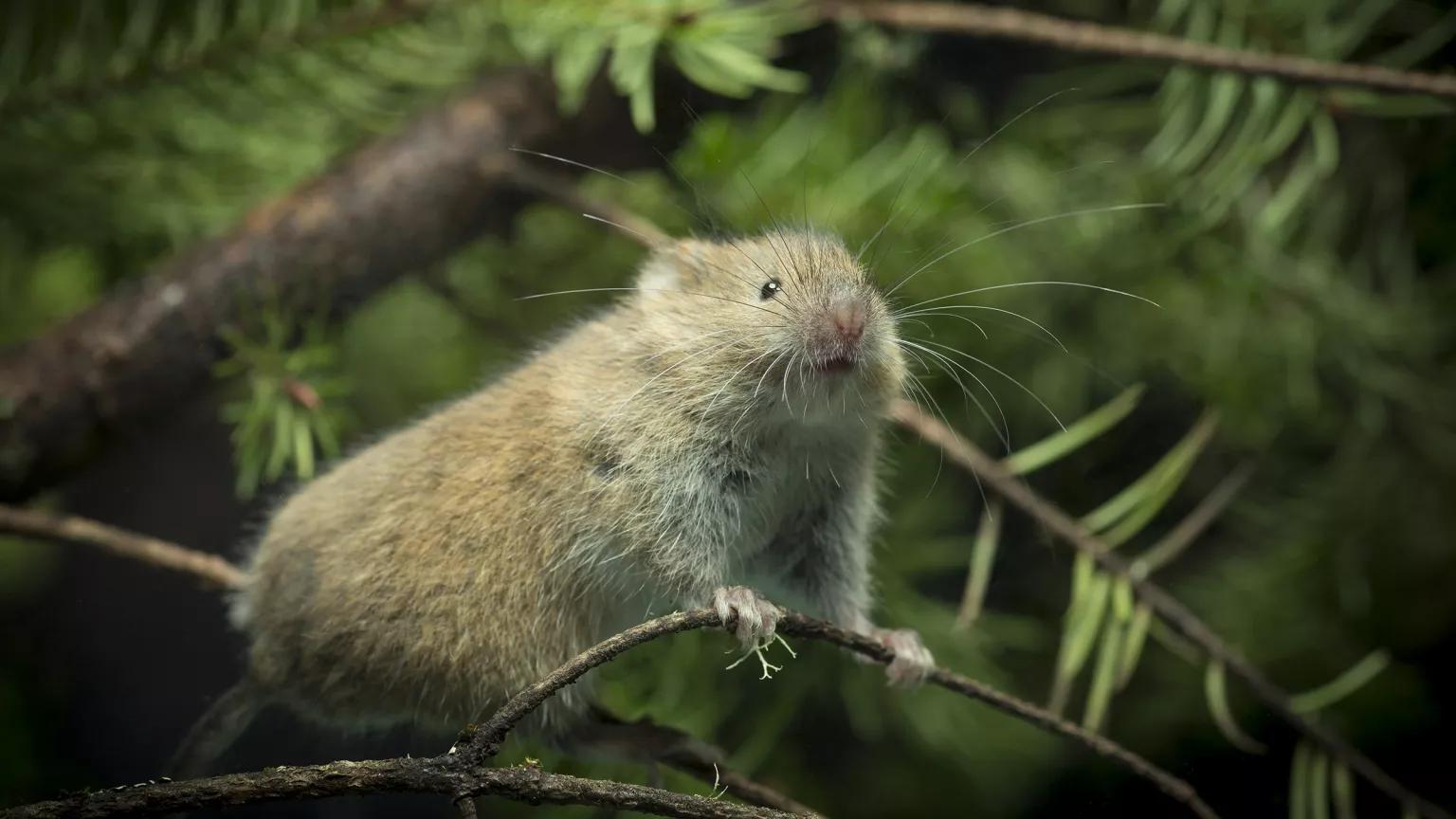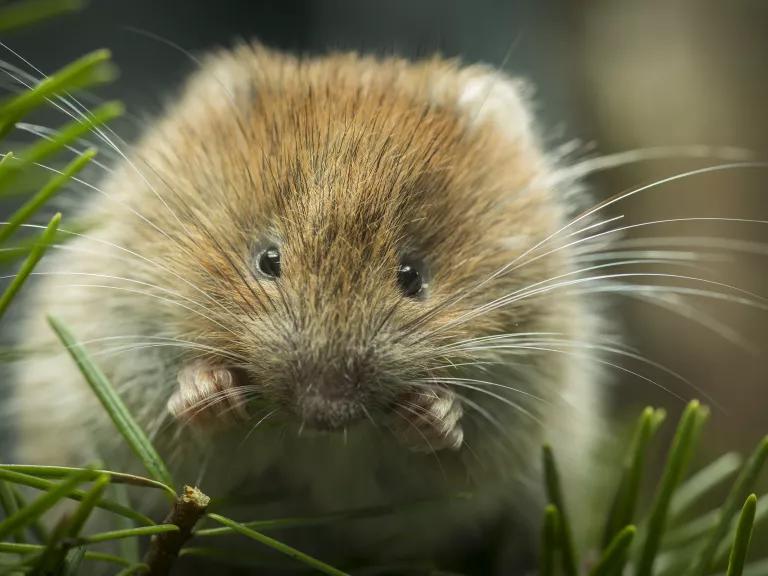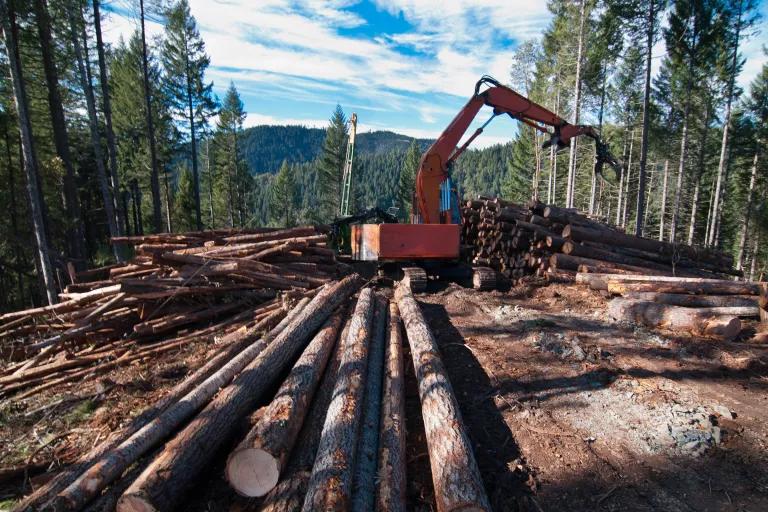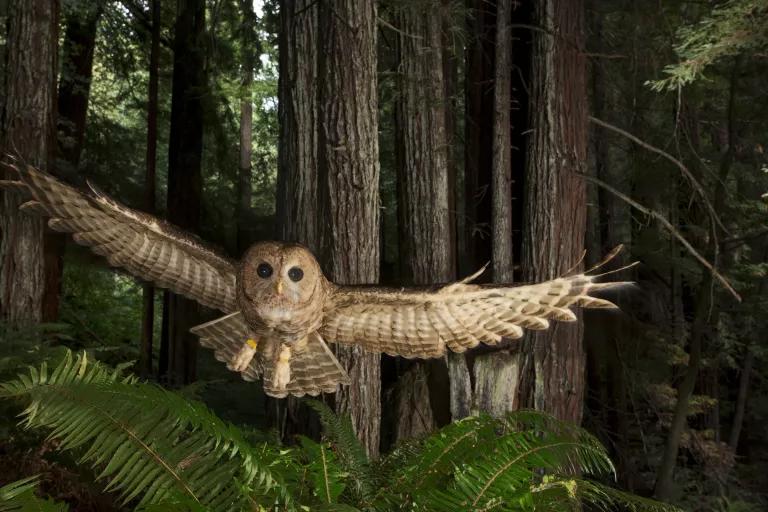These Tiny, Treetop-Living, Ewok-Looking Creatures May Be Getting Socially Distanced to Extinction
Red tree voles spend their whole lives in Oregon’s treetops, but deforestation has cut them off from the rest of their kind.

Michael Durham Photography
In the dark forests of northern Oregon, there dwells a rusty colored mammal species most of us will never see. Known as red tree voles, these four-inch critters are the size of Smurfs, but build solo nests in the sky that look like Ewoks made them. In fact, you might say red tree voles are the ultimate social distancers, since they live alone and almost never venture to the forest floor.
And why would they? Red tree voles survive almost entirely on a diet of twigs and pine needles, which they carefully nibble at in particular places to avoid the needles’ defensive resin ducts. (And with their tiny black eyes, fuzzy round bodies, and long furry tails, they couldn’t be more adorable while nibbling.)
“It’s one of the most specialized mammals in the world,” says Damon Lesmeister, a research wildlife biologist with the U.S. Forest Service. In fact, the critters live completely off the pine needles they collect. Lesmeister says they don’t even need to drink water.
Sadly, the red tree vole may not be around for much longer. Their numbers are in decline, and thanks to deforestation and wildfires, they’re finding fewer and fewer places to build their treetop homes.

Michael Durham Photography
A thousand years ago, the Pacific Northwest was a red tree vole’s paradise. Dense stands of old-growth forest covered up to 85 percent of the Oregon coastal range. Back then, a tree dweller like the vole could look out on what seemed like a continent of interlocking branches covered in prickly green food for hundreds of miles. But in the mid-1800s, gigantic natural fires swept across this region, razing as much as 800,000 acres at a pop. About a century later, loggers started cutting down what was left, reducing the ancient forests to a fraction of their former glory.
Today, a genetically distinct group of red tree voles in northwestern Oregon are stranded on a handful of small habitat islands. Worse still, the vole clusters are disconnected from each other, with no opportunities to mingle and breed. In their separation, their numbers grow smaller by the day. This is why in 2007 the Center for Biological Diversity (CBD) and other environmental groups petitioned the U.S. Fish and Wildlife Service (FWS) to add the “distinct population segment” (DPS) of red tree voles to the Endangered Species List.
Without old-growth trees, red tree voles can’t exist, says Noah Greenwald, the endangered species director at the CBD. “They’re not going to go across clearcuts. So once they’re lost from an area, it’s hard to get them back.”

Logging on forestry land in southern Oregon
Oregon Department of Forestry via Flickr
Indeed, Lesmeister says something as small as a swift stream can be enough to cleave a red tree vole habitat in two, provided there are no interlocking branches running overhead.
Fortunately, after a year of reviewing the available scientific material, the FWS agreed that a listing may be warranted, which sent the whole issue into a full-scale review. By 2011, the agency completed its assessment and declared that adding the red tree vole to the Endangered Species List was “warranted but precluded”. This means that while the red tree voles were dwindling, other species were of a higher conservation concern at the time for the FWS’s limited staff and financial resources. Fair enough. But the finding became a pattern. When the agency conducted its annual reviews, every year between 2012 and 2016, they all ended at the same stop: “warranted but precluded.”
Then in 2017, something happened. Using satellite data and a new kind of survey technology called LiDAR, which stands for Light Detection and Ranging, scientists were able to create a better, more realistic estimate of what Oregon’s treetops looked like. And this led them to conclude that 26 percent of the area surveyed could potentially serve as home to the red tree voles. (To be clear, the report didn’t say the species inhabited all of that space; just that it could.) And while 26 percent of something may not sound like very much, this was actually an increase in habitat from earlier estimates of only 11 percent. Additionally, two of the remaining 11 red tree vole population clusters looked to be in pretty good shape. With protections, the species might stand a chance.
And yet, the FWS declared last December that the red tree vole no longer required federal protection. (Not that it had ever received it, mind you.)
“It really felt like an about-face,” says Quinn Read, Oregon policy director for the CBD. “Their decision is completely at odds with the outlook that was painted in their own assessment.”
For instance, while there are two population blocks doing rather well, five other blocks were found to be of “low resiliency,” which means they don’t have a great chance at persisting. What’s worse, four of those five blocks are estimated to be so small that they will inbreed themselves into oblivion within the next 60 years.

And as for the two good clusters, Read says either one could be wiped out in a single large fire event, which is of course occurring with greater frequency these days, thanks to climate change.
While Lesmeister stopped short of saying he disagrees with the FWS decision, he agrees there is cause for concern. “There's definitely a pretty high risk of extirpation of the remaining isolated populations in the northern part of the DPS,” he says.
But it doesn’t have to be that way. According to Lesmeister, if we managed those forested areas to promote better connectivity between populations, those voles would still have a shot. Better yet, saving the red tree vole doesn’t require a moratorium on logging or other economic activity.
Within 20 years, even a clearcut area could regrow to provide enough canopy cover to help voles disperse into new areas or commingle with existing populations, says Lesmeister. But he stresses that to optimize regrowth, it would be best to let stands of trees grow for 50 to 60 years rather than the 30 to 40 years commonly practiced now.
Honestly, if the red tree vole disappeared tomorrow, most of us would have no idea. Lesmeister studies these animals for a living and says you can search for days without spotting a single fluff.
But the threatened northern spotted owl would certainly take notice. The owls rely on voles for a substantial part of their diet. And there’s little doubt the loss of this species would echo throughout these forests.

A northern spotted owl on the hunt in California
Michael Nichols/ National Geographic Image Collection
“It’s a very important ecological species,” says Lesmeister. “Without red tree voles on the landscape, it becomes a sort of compounding effect.”
The good news is the fur balls may yet get their day in court. In April, the CBD and several other environmental groups made public an intent to sue the FWS over its decision to keep the vole off the Endangered Species list. Nearly a decade and a half have already passed since those same organizations first raised the alarm about the species. All the while, the red tree vole continues to live on the edge.
This NRDC.org story is available for online republication by news media outlets or nonprofits under these conditions: The writer(s) must be credited with a byline; you must note prominently that the story was originally published by NRDC.org and link to the original; the story cannot be edited (beyond simple things such as grammar); you can’t resell the story in any form or grant republishing rights to other outlets; you can’t republish our material wholesale or automatically—you need to select stories individually; you can’t republish the photos or graphics on our site without specific permission; you should drop us a note to let us know when you’ve used one of our stories.

"We Are the Same as the Salmon": A Story of Suffering and Perseverance
The Long, Long Battle for the Arctic National Wildlife Refuge
In Planning for Climate Change, Native Americans Draw on the Past